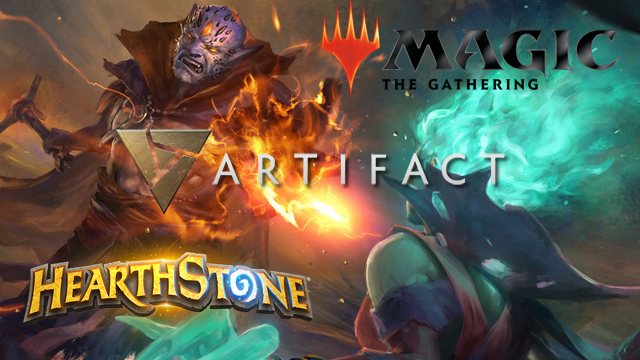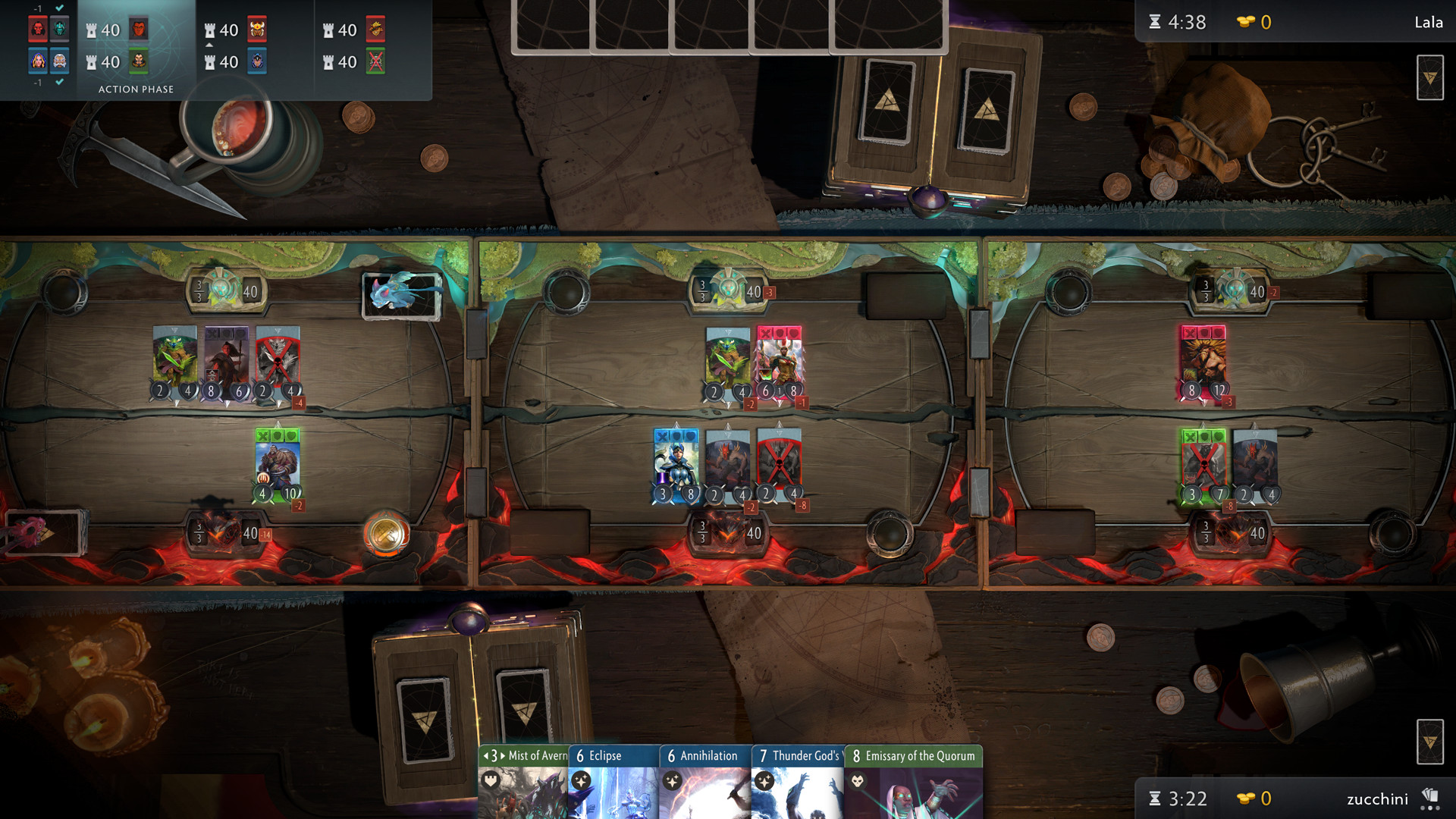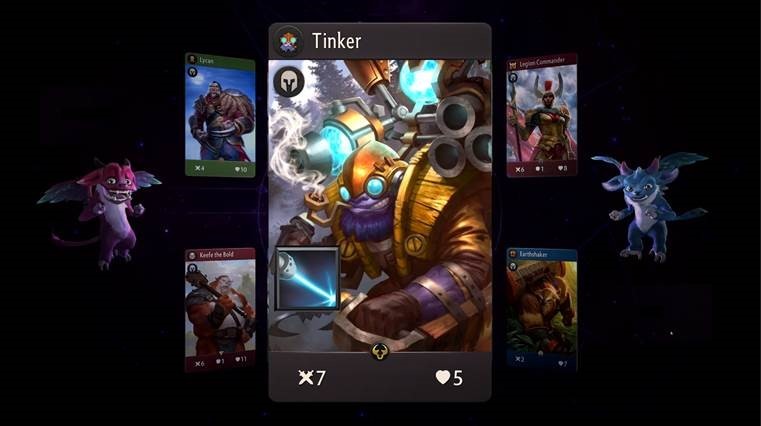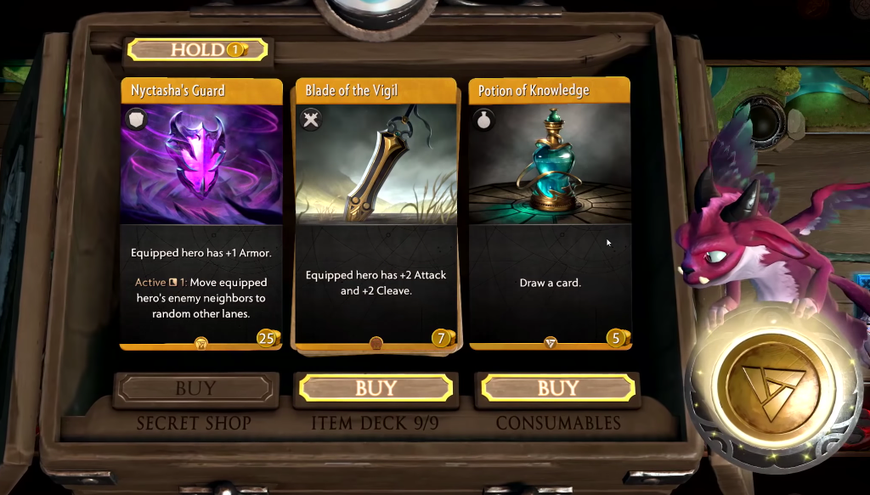Artifact, a brand-new CCG from Valve and Richard Garfield, will enter its beta testing stage on November 19, and it will get a full release on November 28. Invariably, these two dates will mark the beginning of a new CCG era, one that has the potential to dethrone the two CCG mammoths on the market: Hearthstone and Magic: The Gathering.
Artifact offers innovative card game mechanics that combine the best elements of Hearthstone and Magic, which makes its gameplay highly engaging and never boring. But more importantly, Valve’s new CCG will provide a unique card trading system that will prevent pay-to-win schemes that cripple games like Hearthstone and Magic.
However, an obvious hurdle getting Artifact‘s way right out of the gate is that the base game will cost $20, and later, when the new expansions come out, players will have to buy each pack for $2 each. While free-to-play can often hide pay-to-win on the backside, a priced CCG can alienate potential players before they’ve even had a chance to play it.
But pricing is not the only concern CCG players have when it comes to Artifact — there are always concerns regarding systems, economies, and more. Let’s take a look at what other surprises Valve’s new card game might have and if players should be concerned.
Artifact: The Rules of the Game
Before discussing Artifact‘s future and comparing it to other card games, it’s important to understand the mechanics of the game, as they are quite complex. This should come as no surprise since Artifact‘s lead designer is Richard Garfield, the creator of Magic: The Gathering.
If you thought that one board was not enough for a card game, then how about three? These correspond to the three lanes found in games like DoTA 2, where there are three towers at the end of each lane.
Each turn in Artifact includes four phases; we’ll take a look at them below.
Action Phase
At the beginning of each turn, both players are able to start playing their cards (using mana) on each of the three lanes. Mana count starts at three and grows by one each turn. Hero and item cards don’t cost any mana and can be played for free each turn.
When players use all of their mana, they can pass their turns. Then, the Combat phase begins — for both players at the same time.
Combat Phase
Cards that have been placed on the board in the previous phase can now attack each of their opponent’s towers simultaneously. If there is a card blocking an opponent’s card, then the damage goes to the defending card instead of the tower.
When the Combat phase on one lane has been resolved, the game automatically resolves combat on the rest of the lanes.
Shopping Phase
After combat comes the Shopping phase, which serves as a sort of a “break” in the match.
If during the Combat phase players manage to destroy some of the enemy cards or cast spells, they earn gold coins, which can then be spent to buy special items that are either generated by A.I. or manually put in the shop by the players themselves prior to the match-up.
These item cards cost no mana to cast and can enhance the performance of the players for the remainder of the match.
Deployment Phase
During this phase, players can also add two creeps on each lane. What’s more, hero cards are immortal in Artifact, and during the deployment phase, players can replay them on lanes even if they’ve already played them on prior turns.
This phase also begins the card drawing phase, but instead of one card, each player draws two cards. There is no limit on the amount of cards players can hold in their hands.
That is how complex one turn is in Artifact. It includes a vast number of decisions that need to be made on each of the three lanes, as well as devising quick strategies for placement and use.
In the end, a winning player will have to destroy at least two of the three towers in order to claim victory.
How Artifact Fares Against Hearthstone and MtG
Will Hearthstone and/or MtG players see any interest in Artifact?
First of all, it’s already clear that Magic players will have a blast playing Artifact because of its complex gameplay. Richard Garfield is a genius game designer and he knows how to engage players with all kinds of mechanics, including the infamous RNG.
Hearthstone players, on the other hand, will most likely find it difficult to keep up with three boards at the same time. Some of the more experienced HS players do grind on several servers at the same time, but most casual players just want a quick rush of adrenaline.
The time required to finish a game in Hearthstone can be as short as a few minutes, while it’s already obvious one match-up in Artifact may take up to an hour. This fits better with the MtG world, where players tend to spend long turns, pouring over possibilities and strategies.
But time consumption and complex decision-making aren’t the only two factors that will influence how Artifact connects with CCG players. There is one more factor, which is probably the most important one — the game’s monetization system.
Artifact Economics vs. Hearthstone and MtG
Monetization schemes in all three games are very different. Magic and Artifact are tradable card games, meaning that you can buy and sell cards on the open market. Hearthstone, on the other hand, is a collectible card game that requires players to buy packs and craft cards using dust.
Hearthstone also stands out from the other two games because it’s free-to-play. Artifact will cost $20 for the game client, two pre-constructed decks and 120 cards.
Magic Online will cost you $10 for a game client, but you pay nothing if you decide to play Magic Arena instead, which is a far more limited experience.
Artifact cards will be available for purchase on the Steam market and will range from $0.15 to $1. In comparison to Hearthstone, this is decent pricing, as one HS card also costs around $0.30, taking into account the cost of one pack.
MtG in this regard follows a completely different pattern, where cards sell on an extremely volatile market and can reach $1,000+.
This means that if you are ready to spend some cash in Hearthstone, you will be ready to spend the same amount of cash in Artifact — and get a decent amount of good cards. However, if you’ve never spent a single cent in HS, then Artifact might not be your cup of tea as Gabe Newell told PC Gamer in an interview that:
“If time is free, or an account is free, or cards are free, then anything that has a mathematical relationship to those things ends up becoming devalued over time, whether it’s the player’s time and you just make people grind for thousands of hours for minor, trivial improvements, or the asset values of the cards, or whatever. That’s a consequence. So you don’t want to create that flood of free stuff that destroys the economy and the value of people’s time.”
Although it doesn’t look like Artifact will ever have any free components, Newell also said in the same interview that Valve will make sure Artifact will be protected from malicious pay-to-win schemes:
“There are plenty of very common cards that are going to be super powerful. The whole point is to steer away from pay-to-win and that kind of approach. We always want to reward investment. You always want to feel like, as a player, that the more time you spend on it, you’re getting better and you’re enjoying it more.”
This is a good sign and shows that Valve really wants to create something valuable for their fans and not just another clone of Hearthstone or Magic: The Gathering.
Final Thoughts
We can now say for sure that the economics in Artifact is far better in many respects when compared to both Hearthstone, which promotes a shameless pay-to-win system, and MtG, which exploits card markets with its insane prices.
In the case of Artifact, Valve (or the market) will regulate the prices and will not allow the most powerful cards to soar in prices. In this way, everyone who is ready to pay will get the chance to play the game at the highest competitive level.
This is a really smart system that should make many players satisfied. And all of those CCG fans who want to play for free can keep grinding for gold in Hearthstone or Magic Arena.
So, taking all this into account, will Artifact gain any traction after release? The answer is most likely “Yes”, even for the simple fact that it’s a Valve game — the name alone will draw players from far and wide.
It will be interesting to see what niche it carves for itself in the CCG space, and if players are willing to move away from Hearthstone and MtG to play it — or at least give it some space at the table.
—
What do you think about Artifact‘s gameplay mechanics? Do you find them too difficult to understand? What do you think about Valve’s monetization system? Let us know in the comments section below.













Published: Nov 13, 2018 09:38 am